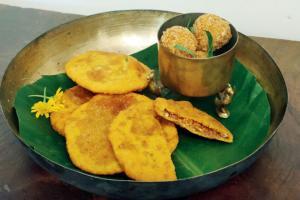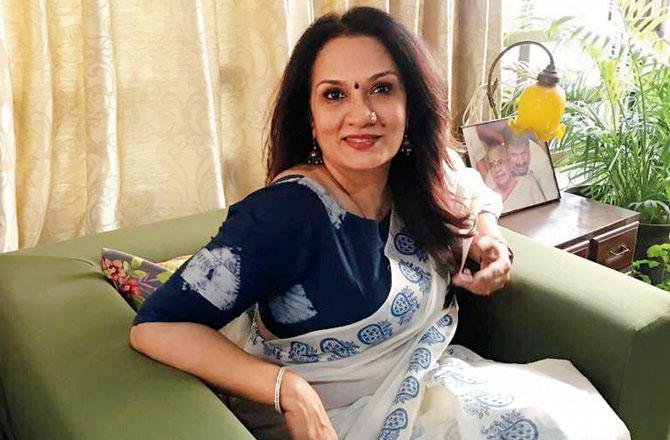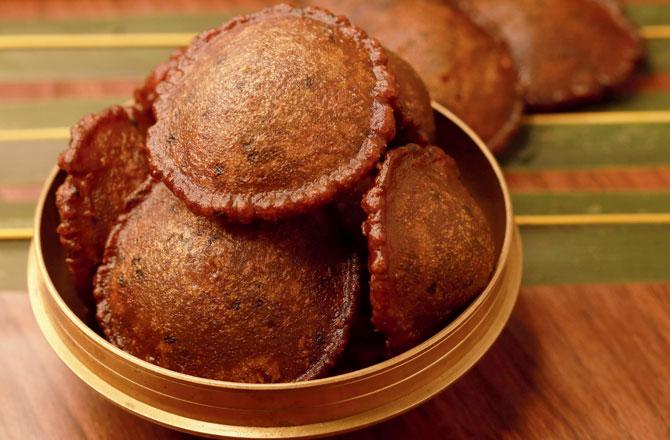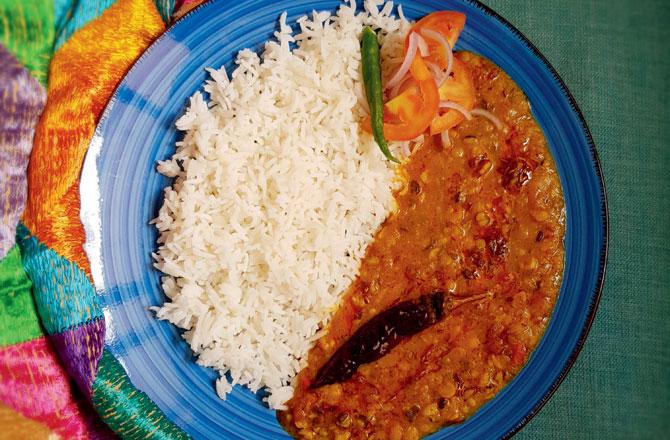A multi ethno-religious country means a million ways to celebrate one festival. Culinary experts from across India share memories and recipes of sweet and savoury Diwali eats

Sajjappa
ADVERTISEMENT

From Karnataka
By chef Rajshri Gupta
Rajshri Gutpa, chef and founder of Beyond Dining Co., grew up in Mumbai, but remained connected to the Malli community traditions through food. Her earliest culinary memory is of her family gathering to prepare sajjappa, a deep fried pastry filled with coconut and jaggery during Diwali. The dish is originally from South Karnataka. "We had a rota system when it came to grating coconut. All members were assigned duties, including kneading, preparing the filling, stuffing and frying. That's how my grandmother and mother ensured we were aware of our traditions and stayed connected as a family." That the ingredients are usually available in Indian homes makes the preparation an easy one.
Ingredients
For pastry
1 cup fine semolina
1/2 cup plain flour or maida
3-4 tbsp ghee
Salt for taste
Water to knead
For filling
1 cup fresh coconut grated
1 cup dry coconut grated
1 1/2 cup jaggery grated
2-3 tbsp fine semolina
2-3 tbsp khus khus or poppy seeds
1 tsp freshly ground cardamom
Oil to fry
Method
In a wide mixing bowl, mix all the pastry ingredients, heat the ghee and add to the mix. Mix it all well. Start adding water little by little and make a soft dough just like chapatti dough. Cover it with a wet cloth and keep aside for around one hour. Heat a pan, dry roast the rava, remove and then roast the khus khus. In the same pan, add jaggery. Once it melts, add coconut, roasted khus khus and rava, and cook till it turns into a thick mixture or till the moisture evaporates. Add elaichi powder, mix and turn the heat off. While still warm, take a bowl of water, dip your fingers and take a small coin-size mixture and make rounds. Now take a small coin-size dough, place it on a sheet and press it with your fingers. Place the filling in the middle, close it and flatten it into puri-sized pancakes. Heat oil, and fry them. Make sure to fry on low heat if you want crispy sajjappa.
Haldi panna patholi

From Maharashtra
By chef Saurabh Wadekar
Haldi panna patholi are turmeric leaf dumplings made mainly by the Gowd Saraswat Brahmin (GSB) community, says chef Saurabh Wadekar, founder of Dashami Kitchens. "The community derives its name from their settlement on the banks of the Saraswati river in North India. The Brahmins migrated southward when the alluvial plains along the settlements started losing fertility. The exodus ended when some of them settled in south and central India," he explains. It's when they settled along the coast of Maharashtra and its southern sister states, that the migrant community was introduced to the delights of sweet dumplings. "They made these with ingredients available in the region, using the simple and traditional method of steaming. Soon, patholi acquired the status of a festive snack." Resembling a steamed modak and shaped somewhat like a karanji (fried coconut filled dumpling), the dish is an amalgamation of salty, sweet and savoury flavours. "It's a delicious example of the cross-cultural ethnicity of our country."

Ingredients
10-12 turmeric leaves
3/4 cup rice
1/4 salt
1/2 cups cardamom powder
1/3 cups grated jaggery
1 cup fresh grated coconut
Method
For rice batter
Soak the rice for five hours. When ready, drain the water and grind into a fine paste. Add a little water if required. Add some rice flour to thicken the batter if necessary.
For the filling
Heat ¼ cup of water and add the jaggery to this. Cook this till you get a viscous syrup. Add the grated coconut and cardamom powder to this when required and allow to cook until you get a semi dry mixture.
Turmeric leaves
Wash the leaves well to avoid any mud or impurities and remove the thick stalk.
Steaming
Seat up a steamer of your preference. On a turmeric leaf, spread the batter thick. In the centre of this, stuff some of the filling and fold the leave shut, like a book. Ensure that the filing does not ooze out. Place these leaf parcels in the steamer and close the lid. Allow to steam for 15-20 minutes. Remove the leaves once cold and serve with melted ghee and metkoot.
God papdi

From Kutch
By home chef Shilpa Meti
Shilpa Meti's Diwali celebrations are never complete without tucking into the scrumptious god papdi. The Kutchi dessert is made with ghee, wheat flour and jaggery. "It's a traditional go-to snack made in each and every household of Kutch. In fact, it's a winter superfood," says Meti. The reason it's prepared during the festive season is because of its hero ingredient, jaggery, which is considered auspicious and healthy. The recipe that Meti uses is one she learnt as an amateur cook from her mother. "We have been savouring this on various occasions; it's close to my heart." Meti says the preparation takes not more than 30 minutes, but be sure to get the quantity of ingredients right if you don't want it to get hard and chewy.

Ingredients
1 cup wheat flour
1/2 cup ghee
2-3 pieces jaggery (as per taste)
1/2 tsp cardamom powder
1 tbsp sliced almonds and other dry fruits of choice
1 tbsp gundar or gond (optional)
Method
Grease a small pan with ghee and keep it ready. Measure the ghee in a pan and heat it in medium heat. Once the ghee is hot, add the measure wheat flour and stir on low flame. Keep cooking till the flour changes colour to a slightly darker shade. Add the cardamom powder and mix well, and in a few minutes, add gundar/gond. Add the jaggery pieces and mix well to combine when melted. Pour the mixture immediately on to another pan or plate and press it down with a spatula to even out. Let the god papdi cool down a bit and then make slices. Cut when still a little warm as it will get difficult to cut once it cools. Let it cool completely and then it's ready to eat or store in a container. It can be stored up to a week.
Neyappam

From Kerala
By chef Sara Jacob Nair
Chef Sara Jacob Nair, founder of Nair on Fire, grew up in Kerala, where Diwali is a relatively quiet affair. Instead, they celebrate Karthika with fervour, that usually falls on the full moon day in November. While Hindu Keralites consider it the birthday of Lord Subramonya, it's also believed to be a dedication to Shakti, popularly known as Bhagavati in Kerala. "This is our festival of lights, when we light diyas outside our homes. We used to make neyyappam using rice and jaggery." Neyyappam translates to appam made in neyyu aka ghee. Jaggery and rice are base ingredients for most Malayali sweets. Crusty on the outside and soft in the inside, it's a rich snack bursting with flavours of sesame and cardamom. "Neyyappam is a complex palaharam [snack] that requires practice and some amount of planning." But, she promises that the effort is worth it.

Ingredients
2 cups raw rice, soaked and drained
300 gm dark Kerala jaggery (Marayur jaggery)
1 cup water
2 cardamom
¼ tsp cumin seeds
¼ tsp ginger powder
2-3 tbsp coconut bits
1 tsp caraway seeds
1/2 tsp black sesame
Coconut oil for frying
2 tbsp ghee
Salt
1 tsp maida (optional for extra softness inside)
Small ripe plantain
Method
Wash and soak the rice for six hours. Strain it and keep aside. Boil the jaggery in the water and make a syrup neither too thin nor too thick. Now grind the rice and cooled jaggery syrup together with jeera, ginger, cardamom and plantain in the mixer. Do not add more water. Fry the coconut bits in a tablespoon of ghee. Add salt, fried coconut bits, caraway seeds and black sesame seeds to the ground rice batter and keep it aside for seven hours to ferment. The consistency is slightly more runny than that of idli batter. After seven hours, you will find the batter slightly thicker. Now heat up the coconut oil in a thick bottomed kadhai till hot. Then take a ladle of the batter and pour into the hot oil. The batter will spread and will be like a flat round than a sphere. Keep it on medium flame till one side is cooked and then turn till the other side is also done.
Langarwali dal

From Amritsar
By chef Amit Puri
For chef and restaurant consultant Amit Puri, Diwali is more than a festival of lights. "It is said that in the early 17th century, when Guru Hargobind was released from prison along with 52 other kings, he reached Amritsar on the last Amavasya in the month of Karthik. This day, known as Bandi Chhor Divas (Day of Liberation), also happens to coincide with Diwali," he says. In Punjab, the day is celebrated in a manner similar to Diwali, with the lighting of diyas in homes and gurdwaras, reading the Guru Granth Sahab, exchanging gifts and having a modest meal at the langar with family. The meal usually consists of dal, roti, rice, sabji, and a sweet preparation. It's the dal that has stayed with Puri, given the fact that it doesn't have a recipe in particular and no two langars serve the same tasting dal. "Since the dal is always served at the community meals at gurdwaras, over the years it got the name langarwali dal. It can also be prepared minus onions and garlic." This recipe is inspired by the gurudwaras he visited in Amritsar.

Ingredients
For dal
½ cup split urad dal (soaked overnight)
¼ cup channa dal (soaked overnight)
¼ tsp red chilli powder
¼ tsp turmeric powder
3 tbs ghee
½ tsp cumin seeds
2 tbs ginger chopped
2 tbs garlicchopped
2 dry red chilies
1 medium size onion
1 medium size tomato
½ tsp hing
1 tbs coriander powder
2 green chilies chopped
Salt
For tadka
1 tbsp ghee
½ tsp cumin seeds
¼ tsp red chilli powder
Chopped
coriander leaves for garnish
Method
Wash the lentils under running water and soak them separately overnight. Drain the water and pressure cook the lentils together with two cups of water, salt, turmeric powder and ¼ teaspoon red chilli powder, for about two whistles. In a kadhai, heat ghee and add ½ teaspoon cumin seeds. Once they splutter, add garlic, ginger and dry red chilies and cook till brown. Add onion and cook till brown. Add tomatoes and cook for five-seven minutes. Add coriander powder and hing and cook for a minute. Add slit green chillies and the cooked onion-tomato mix to the dal and pressure cook once again, for about two whistles, till it gets mushy. Once done, transfer to a serving bowl. For the last tempering, heat ghee and add cumin seeds and red chili powder. Pour this over the dal and garnish with coriander leaves.
Keep scrolling to read more news
Catch up on all the latest Mumbai news, crime news, current affairs, and a complete guide from food to things to do and events across Mumbai. Also download the new mid-day Android and iOS apps to get latest updates.
Mid-Day is now on Telegram. Click here to join our channel (@middayinfomedialtd) and stay updated with the latest news
 Subscribe today by clicking the link and stay updated with the latest news!" Click here!
Subscribe today by clicking the link and stay updated with the latest news!" Click here!






